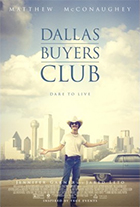Dallas Buyers Club
|  Dallas Buyers Club begins in 1985, the year that AIDS, at the time still largely understood as a “gay disease” and whose name President Ronald Reagan still refused to utter, got its first celebrity face when Rock Hudson admitted to being HIV-positive. That was the year that Ron Woodroof (Matthew McConaughey), an electrician by trade who worked as a weekend rodeo cowboy and spent most of his off time boozing and sleeping with rodeo groupies and prostitutes, was informed that he was HIV-positive. A shallow, self-centered, and deeply homophobic good ol’ boy who felt himself invincible, Woodroof couldn’t fathom that the tests were right, and he refused to believe the doctor’s prognosis that he had only a month to live. As it turned out, Woodroof’s will to live was much stronger than anyone imagined, and Dallas Buyers Club chronicles his unlikely journey from being a small-time rabble rouser to a controversial figurehead of international medical activism, proudly and loudly thumbing his nose at the medical establishment and the FDA as he set up a “buyers club” in his hometown of Dallas, Texas, which allowed him to skirt the laws against selling non-FDA-approved drugs and supplements for the treatment of AIDS symptoms by giving them away in exchange for a monthly membership fee to his club. Dallas Buyers Club begins in 1985, the year that AIDS, at the time still largely understood as a “gay disease” and whose name President Ronald Reagan still refused to utter, got its first celebrity face when Rock Hudson admitted to being HIV-positive. That was the year that Ron Woodroof (Matthew McConaughey), an electrician by trade who worked as a weekend rodeo cowboy and spent most of his off time boozing and sleeping with rodeo groupies and prostitutes, was informed that he was HIV-positive. A shallow, self-centered, and deeply homophobic good ol’ boy who felt himself invincible, Woodroof couldn’t fathom that the tests were right, and he refused to believe the doctor’s prognosis that he had only a month to live. As it turned out, Woodroof’s will to live was much stronger than anyone imagined, and Dallas Buyers Club chronicles his unlikely journey from being a small-time rabble rouser to a controversial figurehead of international medical activism, proudly and loudly thumbing his nose at the medical establishment and the FDA as he set up a “buyers club” in his hometown of Dallas, Texas, which allowed him to skirt the laws against selling non-FDA-approved drugs and supplements for the treatment of AIDS symptoms by giving them away in exchange for a monthly membership fee to his club.Directed by Jean-Marc Vallée (The Young Victoria) from a screenplay by Craig Borten (who interviewed the real-life Woodroof for several days just before his death in 1992) and Melisa Wallack (Meet Bill), Dallas Buyers Club is an entertaining and vigorous anti-establishment ode to mind-over-matter willpower, even as it respects the realities of just how difficult it can be to fight entrenched power (especially when said power emanates from government-corporation collusion). As Woodroof, McConaughey, whose acting renaissance over the past few years has been nothing less than astounding, joins the likes of Robert De Niro, Tom Hanks, and Christian Bale in radically altering his physique by losing close to 50 pounds to play the character, whose physical condition varies from thin and weary to frighteningly emaciated. His cheeks hollowed out and his famously tanned musculature shriveled to skin and sinew, McConaughey tackles the role with dedicated Method gusto, disappearing into a character whose crudity and charm are effectively one in the same. McConaughey’s Texas twang and reedy swagger give Woodroof both lothario bonafides and a sense of vulnerability. Yet, he is most effective when he lets us see the fear beneath the character’s bravado, something he does with great care and nuance. The film’s narrative arc is a conventional portrait of interpersonal growth and spiritual redemption, as Woodroof’s experience as an AIDS patient fighting for his life softens him to the plight of others, particularly all the homosexuals who he earlier would have dismissed as a bunch of “faggots” deserving of their fate. His coarser tendencies remain fully intact from beginning to end, but they are slowly directed away from selfishness and homophobia toward righteous anger at the doctors, nurses, and other faces of conventional medical practice who profess to care for their patients, but are more often than not wedded to the big pharmaceutical companies whose profit motives far outweigh concern for the sick and dying. Woodroof’s main beef with the medical establishment is their adoption of AZT, the first FDA-approved drug to combat AIDS that often did more damage than good (Woodroof almost dies after taking it). Once Woodroof discovers alternative medications that are just as effective, if not more so, but without the deadly side effects (including Compound Q, a Chinese drug explicitly banned by the FDA, Peptide T, and alpha interferon), he sets up shop in a Dallas motel room, where the lines of patients wanting to get into his “club” wrap about the block. At first he smuggles most of the drugs from Mexico (filling the trunk of his Lincoln Continental while he drives disguised as a priest), but soon he is flying all over the world, including Denmark and Japan, to find sympathetic physicians and medical researchers who are willing to supply the drugs. Of course, at first he’s primarily in it for the money, brusquely pushing away anyone who can’t come up with the $400 monthly membership fee, but it doesn’t take a crystal ball to recognize that he will soon see past his own material desires, which parallel the pharmaceutical establishment he is ostensibly fighting. The only real problem with Dallas Buyers Club is that, outside of Woodroof, virtually all of the characters are primarily faces to represent different facets of the AIDS crisis, rather than fully formed human beings. Denis O’Hare’s Dr. Sevard, the physician who first diagnoses Woodroof’s HIV, becomes the face of uncaring, unfeeling medical practice and the primary adversary against unorthodox medical treatment (he lacks only a moustache to twirl). Jennifer Garner’s Dr. Eve Sakes, on the other hand, balances the film’s otherwise unmitigated disdain for the medical establishment by playing a doctor who is sympathetic to Woodroof’s plight to the point of eventually shifting over to full allegiance with his efforts. The fact that she also plays into a semi-romantic subplot is perhaps the film’s most strained narrative device, as there is little chemistry between her and Woodroof. And finally, Jared Leto’s Rayon, a pre-op transgendered AIDS patient who becomes Woodroof’s business partner and eventually good friend, puts a face on the gay community that suffered the most from the AIDS crisis in the early years, particularly because their marginalized social status contributed to the ostracizing of the disease. Thankfully, Leto’s performance (which also involved losing a frightening amount of weight) is strong enough to lift Rayon above being a simple signifier, and his chemistry with McConaughey is such that their relationship becomes truly meaningful. The scene in which Woodroof finally puts aside his bigotry and hugs Rayon is perhaps the film’s most touching moment, encapsulating as it does the real pains of facing death each and every day. Copyright ©2013 James Kendrick Thoughts? E-mail James Kendrick All images copyright © Focus Features |
Overall Rating: 

 (3)
(3)


